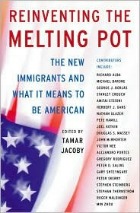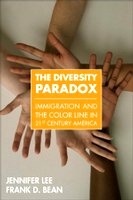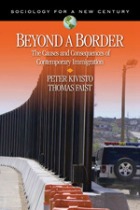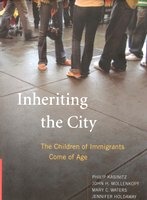January 21, 2010
Written by C.N.
New Books: Immigration
As part of this blog’s mission of making academic research and data more easily accessible, understandable, and applicable to a wider audience and to practical, everyday social issues, I highlight new sociological books about Asian Americans and other racial/ethnic groups as I hear about them. A book’s inclusion is for informational purposes only and does not necessarily mean a full endorsement of its complete contents.
This is the first week of classes for many colleges and universities around the country, including here at the University of Massachusetts, Amherst. This semester I am teaching a new course: “The Sociology of Immigration” (in case you’re curious, you can download a PDF of the syllabus). It’s a topic that is central and directly relevant to many issues that I cover in this blog, and a course that I have always wanted to teach but haven’t had the opportunity to do so until now.
President Obama has also recently suggested that immigration reform is one of the next major policy issues that he and his administration want to address next (although he said this before the upset victory of Republican Scott Brown in MA). Presuming that he follows through on this promise, immigration is set to again move to the front burner of American discussion and controversy.
With these things in mind, I plan on writing a more detailed post about immigration reform soon but in the meantime, I would like to highlight some new books on different aspects of the immigration issue that I will be using as source material for my “Sociology of Immigration” course and that will hopefully provide some sociological data and analysis to help us tackle the question of immigration reform.
The first book, Reinventing the Melting Pot, is the textbook that I have assigned to my students in my “Sociology of Immigration” course.
Reinventing the Melting Pot: The New Immigrants and What It Means To Be American, edited by Tamar Jacoby (Basic Books Publishing)

In Reinventing the Melting Pot, twenty-one of the writers who have thought longest and hardest about immigration come together around a surprising consensus: yes, immigrant absorption still works-and given the number of newcomers arriving today, the nation’s future depends on it. But it need not be incompatible with ethnic identity-and we as a nation need to find new ways to talk about and encourage becoming American.
In the wake of 9/11 it couldn’t be more important to help these newcomers find a way to fit in. Running through these essays is a single common theme: Although ethnicity plays a more important role now than ever before, today’s newcomers can and will become Americans and enrich our national life-reinventing the melting pot and reminding us all what we have in common.
The Diversity Paradox: Immigration and the Color Line in Twenty-First Century America, by Jennifer Lee and Frank Bean (Russell Sage Foundation)

African Americans grappled with Jim Crow segregation until it was legally overturned in the 1960s. In subsequent decades, the country witnessed a new wave of immigration from Asia and Latin America—forever changing the face of American society. In The Diversity Paradox, Jennifer Lee and Frank Bean take these two poles of American collective identity—the legacy of slavery and immigration—and ask if today’s immigrants are destined to become racialized minorities akin to African Americans or if their incorporation into U.S. society will more closely resemble that of their European predecessors.
The Diversity Paradox uses population-based analyses and in-depth interviews to examine patterns of intermarriage and multiracial identification among Asians, Latinos, and African Americans. Lee and Bean . . . show that Asians and Latinos with mixed ancestry are not constrained by strict racial categories. Racial status often shifts according to situation. Individuals can choose to identify along ethnic lines or as white, and their decisions are rarely questioned by outsiders or institutions. These groups also intermarry at higher rates, which is viewed as part of the process of becoming “American†and a form of upward social mobility.
African Americans, in contrast, intermarry at significantly lower rates than Asians and Latinos. Further, multiracial blacks often choose not to identify as such and are typically perceived as being black only—underscoring the stigma attached to being African American and the entrenchment of the “one-drop†rule. Asians and Latinos are successfully disengaging their national origins from the concept of race—like European immigrants before them.
The Diversity Paradox is an extensive and eloquent examination of how contemporary immigration and the country’s new diversity are redefining the boundaries of race. The book also lays bare the powerful reality that as the old black/white color line fades a new one may well be emerging—with many African Americans still on the other side.
Beyond a Border: The Causes and Consequences of Contemporary Immigration, by Peter Kivisto and Thomas Faist (Pine Forge Press)

As the authors state in Chapter 1, “[T]he movement of people across national borders represents one of the most vivid dramas of social reality in the contemporary world.†This comparative text examines contemporary immigration across the globe, focusing on 20 major nations.
Noted scholars Peter Kivisto and Thomas Faist introduce students to important topics of inquiry at the heart of the field, including: (a) Movement: explores the theories of migration using a historical perspective of the modern world; (b) Settlement: provides clarity concerning the controversial matter of immigrant incorporation and refers to the varied ways immigrants come to be a part of a new society; and (c) Control: focuses on the politics of immigration and examines the role of states in shaping how people choose to migrate.
Inheriting the City: The Children of Immigrants Come of Age, by Philip Kasinitz, Mary C. Waters, John H. Mollenkopf, and Jennifer Holdaway (Russell Sage Foundation)

Immigrants and their children comprise nearly three-fifths of New York City’s population and even more of Miami and Los Angeles. But the United States is also a nation with entrenched racial divisions that are being complicated by the arrival of newcomers. While immigrant parents may often fear that their children will “disappear” into American mainstream society, leaving behind their ethnic ties, many experts fear that they won’t—evolving instead into a permanent unassimilated and underemployed underclass.
Inheriting the City confronts these fears with evidence, reporting the results of a major study examining the social, cultural, political, and economic lives of today’s second generation in metropolitan New York, and showing how they fare relative to their first-generation parents and native-stock counterparts. The authors studied the young adult offspring of West Indian, Chinese, Dominican, South American, and Russian Jewish immigrants and compared them to blacks, whites, and Puerto Ricans with native-born parents.
They find that today’s second generation is generally faring better than their parents, with Chinese and Russian Jewish young adults achieving the greatest education and economic advancement, beyond their first-generation parents and even beyond their native-white peers. Every second-generation group is doing at least marginally—and, in many cases, significantly—better than natives of the same racial group across several domains of life. Economically, each second-generation group earns as much or more than its native-born comparison group, especially African Americans and Puerto Ricans, who experience the most persistent disadvantage.
Inheriting the City shows the children of immigrants can often take advantage of policies and programs that were designed for native-born minorities in the wake of the civil rights era. Indeed, the ability to choose elements from both immigrant and native-born cultures has produced, the authors argue, a second-generation advantage that catalyzes both upward mobility and an evolution of mainstream American culture. . . . Adapting elements from their parents’ cultures as well as from their native-born peers, the children of immigrants are not only transforming the American city but also what it means to be American.

